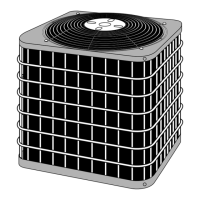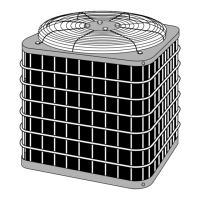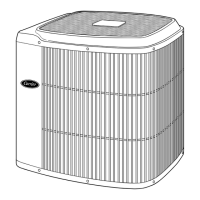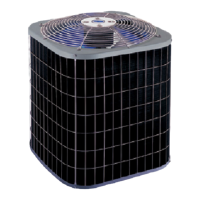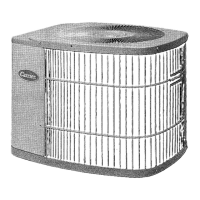Defrost
The defrost control is a time/temperature control which includes a
field-selectable (quick-connects located at board edge) time period
between defrost cycles (30, 50, or 90 minutes), factory set at 90
minutes.
The electronic timer and defrost cycle start only when contactor is
energized and defrost thermostat is closed.
Defrost mode is identical to cooling mode except that outdoor fan
motor stops and second-stage heat is turned on to continue
warming conditioned space.
To initiate defrost, the defrost thermostat must be closed. This can
be accomplished as follows:
1. Turn off power to outdoor unit.
2. Disconnect outdoor fan motor lead from OF2 on control
board. (See Fig. 19.) Tape lead to prevent grounding.
3. Restart unit in heating mode, allowing frost to accumulate on
outdoor coil.
4. After a few minutes in heating mode, liquid line temperature
should drop below closing point of defrost thermostat (ap-
proximately 30˚F).
5. Short between speed-up terminals with a flat-bladed screw-
driver. (See Fig. 19.) This reduces the timing sequence to
1/256th of original time. (See Table 3.)
6. When you hear reversing valve change position, remove
screwdriver immediately; otherwise, control will terminate
normal 10-minute defrost cycle in approximately 2 sec.
NOTE: Length of defrost cycle is dependent on the length of time
it takes to remove screwdriver from test pins after reversing valve
has shifted.
7. Unit will remain in defrost for remainder of defrost cycle time
or until defrost thermostat reopens at approximately 80˚F coil
temperature of liquid line.
8. Turn off power to outdoor unit and reconnect fan motor lead
to OF2 on control board. (See Fig. 19.)
Heating Vapor Pressure Switch
This outdoor unit is equipped with a heating vapor pressure
limiting device which cycles the outdoor fan at high ambient
heating conditions. The exact ambient at which outdoor fan cycles
depends on indoor and outdoor unit sizing. The effect of outdoor
fan cycling on HSPF (Heating Seasonal Performance Factor) is
insignificant, due to its occurrence at outdoor ambients where
building load is very low.
R-410A is a high-pressure refrigerant. The purpose of this switch
is to provide maximum flexibility and minimum cost for the
installer/owner by not requiring special thicker wall vapor tubing
and indoor coils, thus allowing limited retrofit. The use of this
switch also allows the maximum number of indoor coil choices at
minimum cost for the installer/owner, since it can use standard
refrigeration tubing.
NOTE: Due to the presence of a vapor pressure switch in outdoor
unit fan circuit and the possibility of fan cycling, this unit may go
into brief defrost at high ambient heating conditions.
Step 14—Check Charge
UNIT CHARGE
Factory charge is shown on unit rating plate. To check charge in
cooling mode, refer to Cooling Only Procedure. To check charge
in heating mode, refer to Heating Check Chart Procedure.
R-410A refrigerant cylinders contain a dip tube which allows
liquid refrigerant to flow from cylinder in upright position.
Charge R-410A units with cylinder in upright position and a
commercial-type metering device in manifold hose. Charge refrig-
erant into suction line.
COOLING ONLY PROCEDURE
NOTE: If subcooling charging conditions are not favorable,
charge must be weighed in accordance with unit rating plate ± 0.6
oz/ft of 3/8-in. liquid line above or below 15 ft respectively.
EXAMPLE:
To calculate additional charge required for a 25-ft line set:
25 ft - 15 ft = 10 ft X 0.6 oz/ft=6ozofadditional charge
Units installed with cooling mode TXV require charging with the
subcooling method.
1. Operate unit a minimum of 10 minutes before checking
charge.
2. Measure liquid service valve pressure by attaching an accurate
gage to service port.
3. Measure liquid line temperature by attaching an accurate
thermistor type or electronic thermometer to liquid line near
outdoor coil.
4. Refer to Heat Pump Charging Instructions label on outdoor
unit for required subcooling temperature.
5. Refer to Table 4. Find the point where required subcooling
temperature intersects measured liquid service valve pressure.
6. To obtain required subcooling temperature at a specific liquid
line pressure, add refrigerant if liquid line temperature is
higher than indicated or reclaim refrigerant if temperature is
lower. Allow a tolerance of ± 3°F.
Table 3—Defrost Control Speed-Up
Timing Sequence
PARAMETER
MINIMUM
(MINUTES)
MAXIMUM
(MINUTES)
SPEED-UP
(NOMINAL)
30-minute cycle 27 33 7 sec
50-minute cycle 45 55 12 sec
90-minute cycle 81 99 21 sec
10-minute cycle 9 11 2 sec
5 minutes 4.5 5.5 1 sec
Fig. 19—Defrost Control
A91444
OF1
OF2
O
R
T2 Y
TI
DFT
C
TEST
30
50 90
W1
O
R
W2
Y
C
CES0110063,
CES0130024
13

